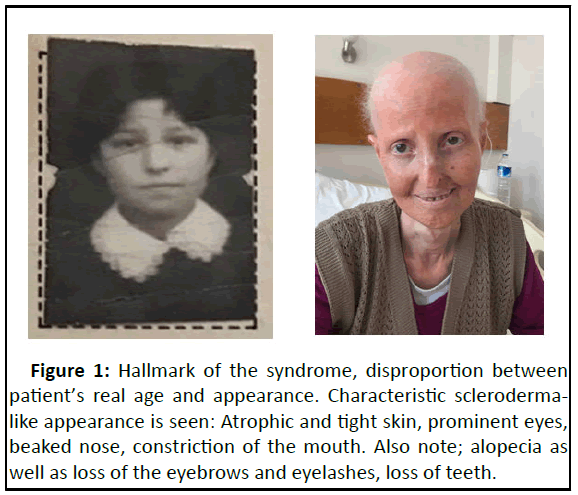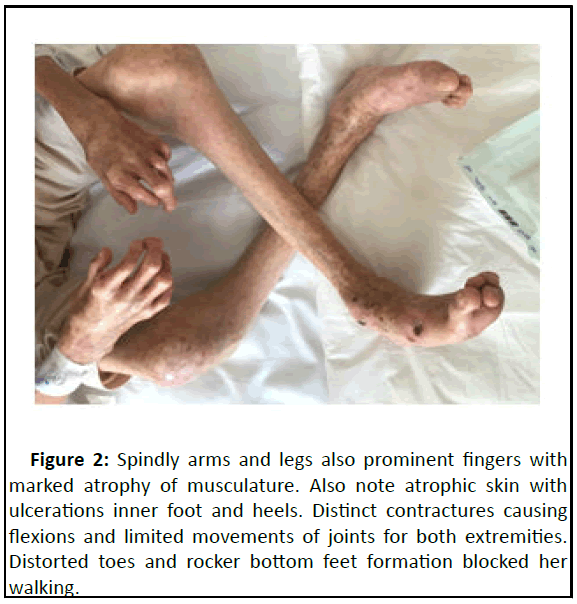A Rare Disease with Premature Aging: Case Report
Cansu Erel, Cemil Tascioglu
Department of Internal Medicine, Istanbul University, Istanbul, Turkey
Published Date: 2023-10-31DOI10.36648/2380-7245.9.5.131
Cansu Erel* and Cemil Tascioglu
Department of Internal Medicine, Istanbul University, Istanbul, Turkey
- *Corresponding Author:
- Cansu Erel
Department of Internal Medicine,
Istanbul University,
Istanbul,
Turkey;
Email: erelcansu.md@gmail.com
Received: Mach 11, 2019, Manuscript No. IPRDDT-23-2868; Editor assigned: Mach 14, 2019, PreQC No. IPRDDT-23-2868 (PQ); Reviewed: Mach 28, 2019, QC No. IPRDDT-23-2868; Revised: October 03, 2023, Manuscript No. IPRDDT-23-2868 (R); Published: October 31, 2023, DOI: 10.36648/2380-7245.9.5.131
Citation: Erel C, et al. (2023) A Rare Disease with Premature Aging: Case Report. J Rare Disord Diagn Ther Vol.9 No.5:131
Abstract
Background: Werner’s syndrome, known as “adult progeria”, is a rare progressive disorder characterized by accelerated aging and cancer predisposition. The frequency of the syndrome is estimated 1 case in 1,000,000.
Case presentation: In this paper, we would like to contribute medical literature by reporting an interesting case of 45-year-old-women, following up for 22 years with Werner’s syndrome manifesting all typical features of the disease.
Conclusions: Werner’s syndrome is a rare disease with unique features. However, it is difficult to recognize because of slow manifestation of typical signs and symptoms. There is no cure option at the moment, early diagnosis and following up these patients are essential because of rehabilitation needs, multiple comorbidities and cancer predisposition.
Keywords
Werner’s progeria; Premature aging; Rare diseases; Hygienic; Bronchogenic cyst
Introduction
Werner’s syndrome, known as “adult progeria”, is a rare progressive disorder characterized by accelerated aging and cancer predisposition. The disorder was originally described in the medical literature in 1904 by German scientist, Otto Werner. The frequency of the syndrome is estimated 1 case in 1,000,000 individuals as well as occurs more often in Japan and Sardenia, affecting 1 in 20,000. It is inherited in an autosomal ressesive pattern causing mutations of WRN gene on 8 p12 chromosome. The WRN gene provides producing Werner protein which is related DNA repair, DNA replication and cell division. The features of the syndrome are scleroderma-like skin changes especially in the extremities, cataract, premature arteriosclerosis, diabetes mellitus and a wizened prematurely aged facies. Although the disorder is typically recognized by the third or fourth decades of life, characteristic findings are found during adolescence and early adulthood [1-3].
The inherited disorder Werner syndrome, is linked to early aging and a higher risk of cancer and other diseases. Werner syndrome symptoms typically appear in adolescence or childhood. Werner syndrome is characterized by a lack of the regular teenage growth spurt and a tendency to be shorter than average. People in their 20s may start to show aging symptoms like wrinkles, gray hair and hair loss. Cataracts or clouding of the eye's lens, type 2 diabetes, skin ulcers, a beaked nose and osteoporosis or a decline in bone mineral density, are just a few of the symptoms that may appear in a person's 30s. The early onset of numerous health issues is one of the most serious health issues confronted by people with Werner syndrome. Normally, each gene is present in two copies in each cell, one from the mother and one from the father. Werner syndrome is an autosomal recessive pattern of inheritance, which means that for a person to be affected, the mutation in both copies of the gene must exist. This implies that for a child to be impacted by a gene mutation, both parents must pass it on. Carrier refers to a person who carries the gene mutation in just one copy. A child has a 25% probability of inheriting two mutations and being impacted when both parents carry a recessive gene mutation. When a potential parent inherits a gene mutation that raises the risk of infertility, there are options available to those who are interested in having a child [4,5].
Case Presentation
A 45-year-old-woman was admitted to the hospital complaining of purulent discharge from both elbows and hips. About 2 years prior to admission the patient had noted similar complaints which were diagnosed and treated as osteomyelitis [6].
She stated to be healthy until 23 years old when she had a surgery for bilateral cataracts. She wasn’t diabetic then and doctors said “cataract is arising from her body” inn the words of patient. Following the operation her complaints started with often falls, weight loss and muscle weakness [7]. The symptoms had been thought as drug adverse effects while her hair became feathery and sparse together with deformation of legs’ shape causing progressive difficulty in her walking. She hasn’t walked for 10 years which explicit deterioration has occurred. Stiffness, muscle contractures on joints and paresthesia especially on hands has caused decreasing her self-care ability which she couldn’t eat or take a shower by her own since 2016. Painful recurrent sores which were diagnosed and treated as osteomyelitis developed recently on defined joints [8-10].
The periods had started at the age of 14. She had married at 20 and got pregnant once at 23 ended up stillbirth with an unfound cause after 9 months’ gestation. She had hysterectomy operation because of uterine residual tissue. She divorced from her husband after delivery. The parents of the patient weren’t relatives yet they were from the same village. The patient had 3 siblings who all had cataract history despite of absent diabetes mellitus. Otherwise there was no relatives suffered from Werner’s syndrome. A sister had asthma and goiter while a brother had cerebral hemorrhage which the etiology was unclear. Other brother was healthy [11].
The patient weighed 23 kg with cachexic appearance. She was on average intelligence and looked cheerfully. As hallmark of Werner’s syndrome she looked like extremely older than she was because of disproportion between patient’s real age and appearance. Strikingly characteristic scleroderma-like appearance of Werner's syndrome was seen on the patient’s face which were atrophic and tight skin, prominent eyes, beaked nose, constriction of the mouth [12]. She had diffuse alopecia and few feathery white hair as well as sparse eyebrows and eyelashes (Figure 1).
Figure 1: Hallmark of the syndrome, disproportion between patient’s real age and appearance. Characteristic sclerodermalike appearance is seen: Atrophic and tight skin, prominent eyes, beaked nose, constriction of the mouth. Also note; alopecia as well as loss of the eyebrows and eyelashes, loss of teeth.
Results and Discussion
She complained about difficulty on seeing near. Oropharynx was clear except oral hygiene was not well and she lost a number of her teeth. The voice was weak and high-pitched confirmed by the patient’s statement. Patient also expressed hoarseness since 2016 which was thought to be related cervical bronchogenic cyst on neck. Pectus excavatum was noted on respiratory system examination. Respiratory and cardiac auscultation revealed normal sounds. There was loose skin on abdomen and slight tenderness on umbilical area but no palpable masses, defans or rebound [13].
She had spindly arms and legs with marked atrophy of musculature. Besides severe wasting (atrophy) of extremity muscles, deficiency of adipose tissue was noted. Moreover, distinct contractures caused flexions and limited movements of joints for both extremities. She couldn’t walk or stand because of rocker bottom feet formation [14,15]. There were multiple small necrotic ulcerations noted on fingertips (Figure 2).
Figure 2: Spindly arms and legs also prominent fingers with marked atrophy of musculature. Also note atrophic skin with ulcerations inner foot and heels. Distinct contractures causing flexions and limited movements of joints for both extremities. Distorted toes and rocker bottom feet formation blocked her walking.
Conclusion
Werner’s syndrome is a rare disease with unique features. However, it is difficult ot recognise because of slow manifestation of typical signs and symptoms. There is no cure option at the moment, early diagnosis and following up these patients are essential because of rehabilitation needs, multiple comorbidities and cancer predisposition. To help lower the risk of heart disease and other age-related problems, people with Werner syndrome should also avoid smoking and physical injuries, stay physically active and keep a healthy weight. Any angina, often known as chest pains,s hould be thoroughly examined by a physician. Werner syndrome sufferers should also restrict sun exposure and use sun protection when outdoors due to the risk of skin cancer. As new technologies are created and more is discovered about Werner syndrome, screening guidelines may alter over time.
Author’s Contributions
CE did manuscript writing/editing. CT was involved manuscript editing. Both authors read and approved the final manuscript.
Ethics Approval and Consent to Participate
Not applicable.
Consent for Publication
Written informed consent was obtained from the patient for publication of this case report and any accompanying images. A copy of written consent is available for review by the editor-inchief of this journal.
Competing Interests
The authors declare that they have no competing interests.
References
- Muftuoglu M, Oshima J, von Kobbe C, Cheng WH, Leistritz DF, et al. (2008) The clinical characteristics of Werner syndrome: Molecular and biochemical diagnosis. Hum Genet 124: 369-377.
[Crossref] [Google Scholar] [PubMed]
- Reisz Z, Troakes C, Sztriha LK, Bodi I (2022) Fatal thrombolysis-related intracerebral haemorrhage associated with amyloid-β-related angiitis in a middle-aged patient-case report and literature review. BMC Neurol 22: 500.
[Crossref] [Google Scholar] [PubMed]
- Beauregard S, Gilchrest BA (1987) Syndromes of premature aging. Dermatol Clin 5: 109-121.
[Google Scholar] [PubMed]
- Cabanillas R, Cadinanos J, Villameytide JA, Perez M, Longo J, et al. (2011) Nestor-Guillermo progeria syndrome: A novel premature aging condition with early onset and chronic development caused by BANF1 mutations. Am J Med Genet A 155: 2617-2625.
[Crossref] [Google Scholar] [PubMed]
- Riveros CJP, Gavilan MFB, Franca LFS, Sotto MN, Takahashi MDF (2004) Acquired localized cutis laxa confined to the face: Case report and review of the literature. Int J Dermatol 43: 931-935.
[Crossref] [Google Scholar] [PubMed]
- Stinco G, Governatori G, Mattighello P, Patrone P (2008) Multiple cutaneous neoplasms in a patient with Rothmund-Thomson syndrome: Case report and published work review. J Dermatol 35: 154-161.
[Crossref] [Google Scholar] [PubMed]
- Fisher BK, Page E, Hanna W (1989) Acral localized acquired cutis laxa. J Am Acad Dermatol 21: 33-40.
[Crossref] [Google Scholar] [PubMed]
- Reed WB, Horowitz RE, Beighton P (1971) Acquired cutis laxa: Primary generalized elastolysis. Arch Dermatol 103: 661-669.
[Google Scholar] [PubMed]
- Fitzsimmons JS, Fitzsimmons EM, Guibert PR, Zaldua V, Dodd KL (1985) Variable clinical presentation of cutis laxa. Clin Genet 28: 284-295.
[Crossref] [Google Scholar] [PubMed]
- Greenbaum SS, Krull EA, Rubin MG, Lee R (1989) Localized acquired cutis laxa in one of identical twins. Int J Dermatol 28: 402-406.
[Crossref] [Google Scholar] [PubMed]
- Riveros CJP, Gavilan MFB, Franca LFS, Sotto MN, Takahashi MDF (2004) Acquired localized cutis laxa confined to the face: Case report and review of the literature. Int J Dermatol 43: 931-935.
[Crossref] [Google Scholar] [PubMed]
- Harpey JP, Jaudon MC, Clavel JP, Galli A, Darbois Y (1983) Cutis laxa and low serum zinc after antenatal exposure to penicillamine. Lancet 322: 857-858.
[Crossref] [Google Scholar] [PubMed]
- Yoneda K, Kanoh T, Nomura S, Ozaki M, Imamura S (1990) Elastolytic cutaneous lesions in myeloma-associated amyloidosis. Arch Dermatol 126: 657-660.
[Google Scholar] [PubMed]
- Machet MC, Machet L, Vaillant L, Esteve E, de Muret A, et al. (1995) Acquired localized cutis laxa due to cutaneous lymphoplasmacytoid lymphoma. Arch Dermatol 131: 110-111.
[Google Scholar] [PubMed]
- Cho SY, Maguire RF (1980) Multiple myeloma associated with acquired cutis laxa. Cutis 26: 209-211.
[Google Scholar] [PubMed]
Open Access Journals
- Aquaculture & Veterinary Science
- Chemistry & Chemical Sciences
- Clinical Sciences
- Engineering
- General Science
- Genetics & Molecular Biology
- Health Care & Nursing
- Immunology & Microbiology
- Materials Science
- Mathematics & Physics
- Medical Sciences
- Neurology & Psychiatry
- Oncology & Cancer Science
- Pharmaceutical Sciences


